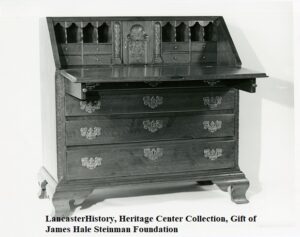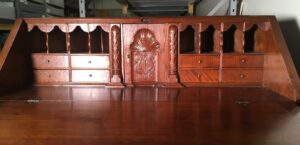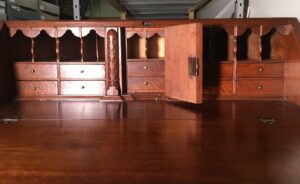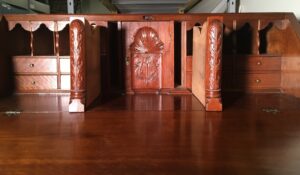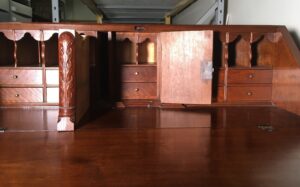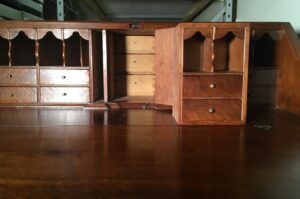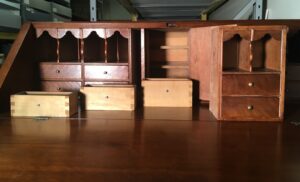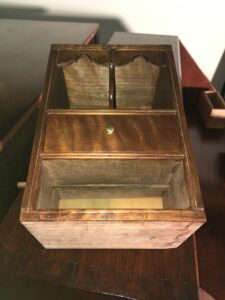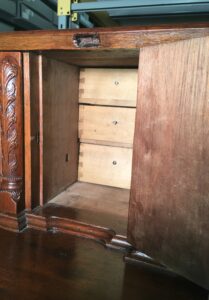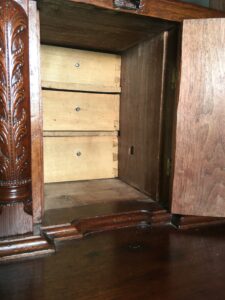The Case of the Secret Compartment
The Slant-Front Desk
For those of you familiar with the National Treasure movie franchise, this story of a secret (but empty) compartment in a Chippendale style walnut slant-front (or slant-top) desk might seem rather ordinary. Even so, the discovery of such a compartment in an eighteenth century desk of local manufacture speaks not only to the ingenuity of local cabinetmakers, but to the sophistication and wealth of the local consumer market.
Combining the functions of both chest and desk, the slant-front desk consists of a series of drawers, usually four as in this case, below a hinged lid. The drawers offer ample storage for household goods. When opened, the hinged lid rests on two extensions to support the weight of a writing surface. In addition to providing a writing area, the open lid offers access to several small nest drawers and pigeonholes for storing writing materials and domestic records as well as a central prospect box. This prospect box is covered with a hinged prospect door that can be locked to provide added security.
The Investigation
In removing the two-over-two nest drawers on either side of the central prospect door to examine their construction, I noticed that they extended all the way to the three horizontally laid backboards of the piece. When I unlocked the prospect door to remove the nest drawers of the prospect box, I noticed that they were much shallower than those in the main part of the desk. I also noticed that although the prospect door could not be opened fully because the vine carved acanthus leaved quarter column on the hinge side of the door projected past the adjacent pigeonhole and nesting drawer storage unit, the door opened just wide enough so that the nesting drawers of the prospect box could be removed. Closer examination revealed that both columns were not only removable, but provided additional storage space as well. Once the column on the hinge side of the prospect door was removed, a slight tug on the prospect box proved it to be loose. Slowly moving the prospect box forward revealed a bank of three graduated tulip-popular drawers. Unfortunately, this secret compartment failed to produce any treasurers or inscriptions.
The Secret Compartment
A secret compartment hidden within this matrix of drawers and compartments would provide the owner with peace of mind and an extra measure of security for protecting family treasurers. But how could the prospect box be locked into place so that the hidden compartment could be secured from would-be thieves? The trick was to employ a simple wooden slide. By cutting a groove into the bottom of the upper drawer divide near the back, the slide could be moved back and forth so that it exited a hole in either side of the prospect box and entered a corresponding cavity designed to accept the tip of the slide on either side of the surrounding partition. Since the slide was only accessible with the bottom drawer removed and only visible when looking into the box from below the level of the writing surface, only someone familiar with the details of construction would be able to access the secret compartment
The Heart of the Matter
Although the brass draw pulls of this have been replaced and we do not know the maker of this desk, stylistic details indicate that it was most likely crafted during the late Chippendale period, between 1780 and 1800. The shell carving on the prospect door is of particular interest. The concave carving is quite intricate; a radiating ribbed shell with a scalloped outer edge. A close examination also shows areas of matting or stippling (a pattern of small dots used to create areas of light and shadow). Although the fine relief carving throughout the piece reflects the influence of English-based Philadelphia Chippendale furniture, the appearance of the small heart near the bottom of the prospect door may be indicative of the influence of local Pennsylvania German tradition. A chalk inscription repeated twice across several of the horizontal backboards reads “Charles Seiber, Lancaster.” Due to the ephemeral nature of chalk and because it is extremely rare to find an eighteenth century piece of furniture with a genuine label or signature by its maker, this name most likely refers to a later owner rather than to the maker.
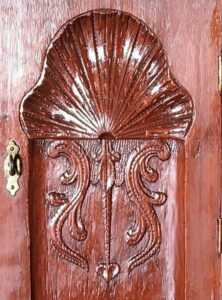
While this adventure may fall far short of National Treasure’s “Greatest Adventure” tagline, I hope you have enjoyed learning as much about this remarkable piece of furniture as I have had in investigating and sharing its secrets with you.
From Object Lessons

